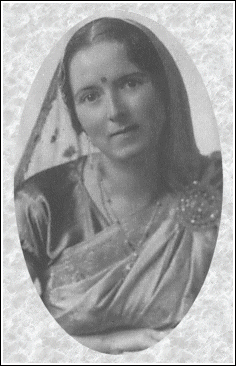

Savitri Devi: Life and WorkIrmin |
 Savitri Devi, priestess of esoteric national
socialism, was born Maximiani Portas on September 30, 1905, in Lyons, France,
of a Greek father and an English mother. [Image: Savitri in India, c. 1935.]
Savitri Devi, priestess of esoteric national
socialism, was born Maximiani Portas on September 30, 1905, in Lyons, France,
of a Greek father and an English mother. [Image: Savitri in India, c. 1935.]
The passionate iconoclasm that would mark so much of her life began early: At age eleven, during the First World War, she chalked anti-Entente slogans on the Lyons railway station ("Down with the Allies, Long Live Germany") as a protest against the illegal Allied invasion of neutral Greece. A true polymath, Portas earned degrees in chemistry and philosophy, wrote her doctoral thesis on the philosophy of science, and would eventually master at least seven languages, including Bengali and Hindi. Her earliest political convictions were pan-Hellenic, and in 1928 Portas renounced her French citizenship and became a Greek national. While studying in Athens her political nationalism, along with a fascination with Greco-Roman antiquity and a mistrust of Christianity, evolved into a broader pagan racialism, and a visit to Palestine in 1929 convinced her that Judeo-Christianity, whose outward observances in the Holy Land repelled her, was an alien intrusion into the West, distorting its natural spiritual evolution and imposing upon it a sterile monotheism and a servile philo-Semitism. It was in Palestine, she later said, that she first realized she was a National Socialist. In 1932 she traveled to India, in search of the Aryan paganism that Judeo-Christianity had supplanted. On the subcontinent she sought "gods and rites akin to those of ancient Greece, of ancient Rome, of ancient Britain and ancient Germany, that people of our race carried there, with the cult of the Sun, six thousand years ago." Her exemplar was Julian the Apostate, the fourth-century emperor who briefly restored paganism and the cult of the Sun to the Roman Empire. Portas took up residence in Calcutta and
quickly immersed herself in the Hindu nationalist movements, lineal ancestors
of the modern BJP, that were then waging a two-front political campaign
against Islam and British colonialism. She worked as a traveling lecturer
for the Hindu Mission, a nationalist organization with NS sympathies, and
adopted the Hindu name Savitri Devi, after the Indo-Aryan sun-god (cf.
Rig Veda 3.62.10). Her new racialist Hinduism was a reflection of her NS
beliefs: In the swastika, the Aryan sun-wheel, she saw "the visible link
between Hitler and orthodox Hinduism."
In 1940, largely to avoid deportation for her pro-Axis activities, Savitri married the Brahmin Asit Krishna Mukherji, pan-Aryan editor of the openly NS journal New Mercury. During the war the couple gathered intelligence on behalf of the Axis, and Mukherji put militant Hindu nationalist Subhas Chandra Bose in contact with the Japanese, who would later support his Indian National Army in its abortive campaign against the British. Savitri was overwhelmed by Germany's defeat and post-war dismemberment. She returned to Europe in 1945 determined to propagandize on behalf of her now reviled NS beliefs, staying briefly in London (where she published Son of God, her study of Akhnaton's solar religion), France, Iceland, Scotland (where she began her most influential work, Lightning and the Sun) and Sweden (where she met Sven Hedin, the famous explorer and committed national socialist). In 1948 and 1949, at the height of de-nazification, she conducted a series of clandestine propaganda missions into a prostrate Germany still devastated by mass starvation and the Allied terror bombing, distributing leaflets and posting handbills urging resistance to the often brutal occupation:
Savitri was eventually arrested along with a comrade in February 1949, convicted of promoting national socialist ideas, and sentenced to six years imprisonment, of which she served only seven months, returning to Lyons in the summer of 1949. There she wrote Defiance and completed Gold in the Furnace, both based on her experiences in occupied Germany. [Image: An Aryan racial loyalist salutes the Sun rising behind the rubble of bombed-out Germany; Savitri's own cover art for Defiance.]
Savitri returned to India in 1957, but was back in Europe three years later. The friendships she had made during her imprisonment provided entrée into murky world of post-war national socialism -- she was already on friendly terms with such luminaries as Hans Rudel, Otto Skorzeny, and Leon Degrelle -- and while living in London she became involved with the politics of the British Racial Right, attending, along with George Lincoln Rockwell, the international WUNS conference in the Cotswolds in 1962, site of the famous Cotswold Declaration. In 1971 Savitri returned again to India, where she spent most of the 1970s corresponding with her comrades abroad and influencing a number of young racialists who visited her in Delhi. She died in the United Kingdom in 1982, while preparing for a speaking tour of the United States. |

|

|